|
|
File
Civic Museum – Asolo
|
Via Regina Cornaro 74 – 31011 Asolo (TV)
– Fax 0423 55745 |
  |
|
Summary
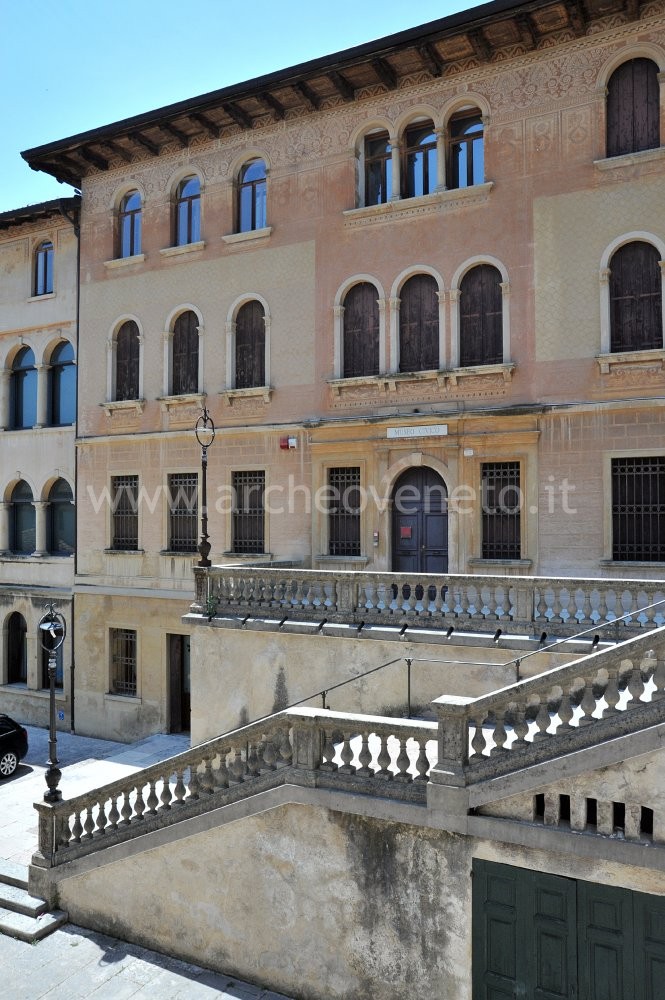
The civic museum of Asolo, which is located in the Bishop’s Palace, hosts the archaeological collections, the Picture gallery, the Cathedral Treasure and a section devoted to Caterina Cornaro and Eleonora Duse. The archaeological section, which is organized in six rooms, displays the material discovered thanks to the excavations carried out in the nineteenth and twentieth century in the municipality of Asolo and its surroundings. This material, which dates back to a time span between Paleolithic and the Middle Ages, confirms the topographic importance of Asolo since ancient times and the central role that this town played over the centuries in the trade relations between the valley and the mountain.
Collection history
After Pacifico Scomazzetto’s sudden and premature death, in 1986, his heirs interpreted his will, donating all the artistic-historical and archaeological material he had collected, to the municipality of Asolo with the purpose of establishing the civic museum. Even though donations had been made for more than 50 years, it was only in that very moment, that the museum was officially established in the Sala della Ragione, which hosted the Town Hall too.
Thereafter private donations increased, thus leading to a remarkable growth in the material displayed in the museum.
|

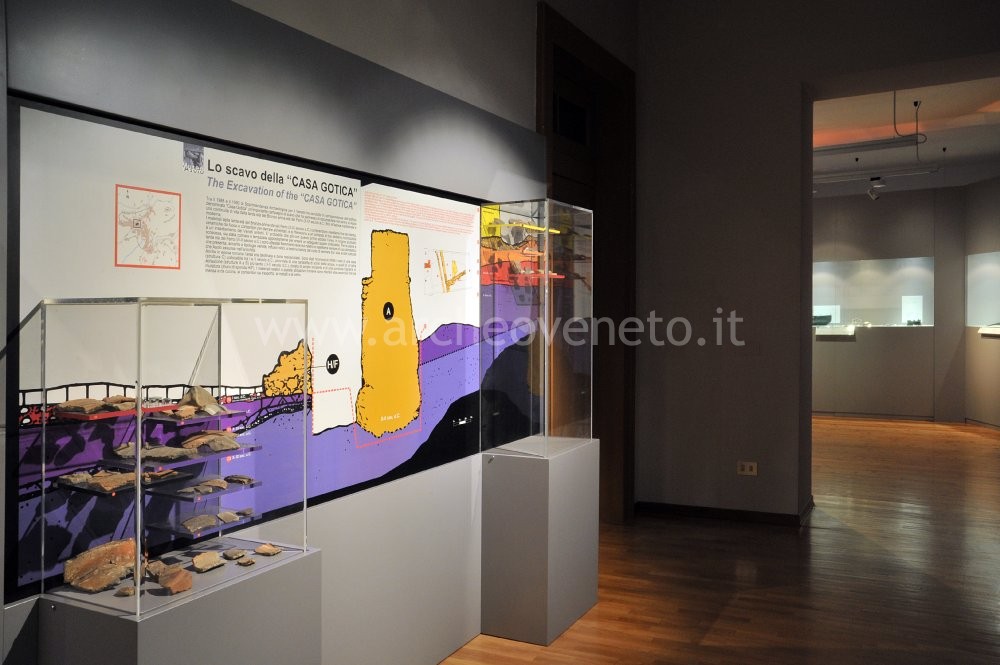 The first room of the archaeological section hosts the archaeological finds discovered in the area around Asolo thanks to the excavations carried out by the Regional Board for the Protection of the Cultural Heritage (Soprintendenza) during the last century. The area surrounding Asolo has been inhabited since the Middle Paleolithic (300,000-35,000 years ago); the extraordinary remains of a mammoth discovered in Pagnano d’Asolo, which unfortunately are not displayed here, date back to this period. Also the Mousterian flint artefacts (a point and two “Levallois” flakes) found in Fornaci di Casella d’Asolo, which prove the sporadic presence of Neanderthals in this area, can be traced back to the Middle Paleolithic. The first room of the archaeological section hosts the archaeological finds discovered in the area around Asolo thanks to the excavations carried out by the Regional Board for the Protection of the Cultural Heritage (Soprintendenza) during the last century. The area surrounding Asolo has been inhabited since the Middle Paleolithic (300,000-35,000 years ago); the extraordinary remains of a mammoth discovered in Pagnano d’Asolo, which unfortunately are not displayed here, date back to this period. Also the Mousterian flint artefacts (a point and two “Levallois” flakes) found in Fornaci di Casella d’Asolo, which prove the sporadic presence of Neanderthals in this area, can be traced back to the Middle Paleolithic.
The following display case contains Mesolithic materials and tools (a core, trapezoidal armours, small blades, a backed knife, a punch and three scrapers) found in the site Fondo Bavaresco, in Pagnano d’Asolo, which provide important information on the activities carried out by prehistoric people.
The lithic finds displayed in the third case date back to Neolithic and the early Bronze age. These flint artefacts come from Casella d’Asolo and bear witness to the social and economic changes experienced by the prehistoric man in the transition from nomadism to sedentariness.
The last display case/panel refers to the material found during the excavation of the so called Casa Gotica (Gothic House) located in the city centre of Asolo. The material, which consists only of pottery (cookware, dinnerware and transport vessels) proves an interrupted human presence in the area from the 10th-9th cent. B.C. (Bronze/Iron Age) to the 1st cent. A.D. (Roman period), which was characterised by different settling stages.
|

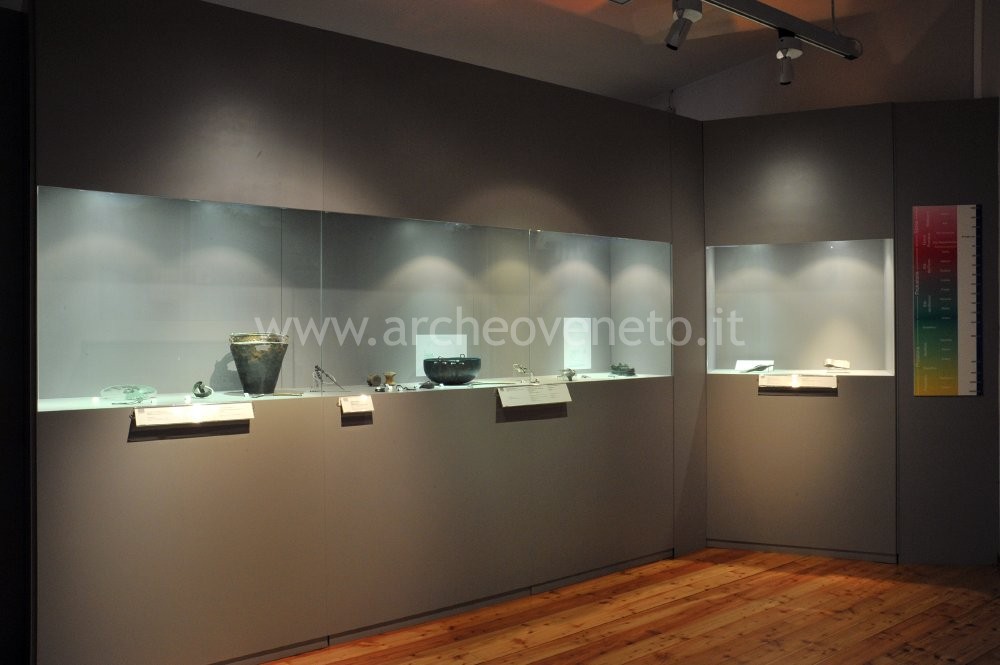 This room is devoted to the protohistoric finds discovered in the area around Asolo. This room is devoted to the protohistoric finds discovered in the area around Asolo.
As soon as you enter the room, you see on your right a display case containing the reconstruction of a pre-roman votive deposit (2nd-1st cent. B.C.) found in the area of the Roman theatre, where the remains of a public ritual sacrifice were laid (animal bones with Venetic inscriptions, eggs, four Venetic drachmas and a grey clay bowl). Next to this material, there is a display case containing three small bronzes of the 4th cent. B.C., two of unknown origin and one from Santa Giustina d’Asolo.
The large display case in front of the entrance contains either material from sporadic discoveries or grave goods found in two burial grounds of the area: the necropolises of Biordo and of Borso del Grappa. The occasional discoveries include a flanged axe from the Middle/Recent Bronze Age, an axe of the 7th cent. B.C. and three pins of the 7th-6th cent. B.C. The material found in the Venetian necropolis of Biordo includes fragments of situlae (6th-5th cent. B.C.), a twisted handle, three fragments of lebetes (8th-7th cent. B.C.), “leech” fibulae (8th-7th cent. B.C.), an armilla (6th-5th cent. B.C.) and two reels (7th cent. B.C.), whereas the objects discovered in the protohistoric necropolis of Borso del Grappa consist of a situla with twisted handles (6th cent. B.C.), a lid (6th cent. B.C.), a fibula and a fragment of a hemispheric single-handle cup.
|

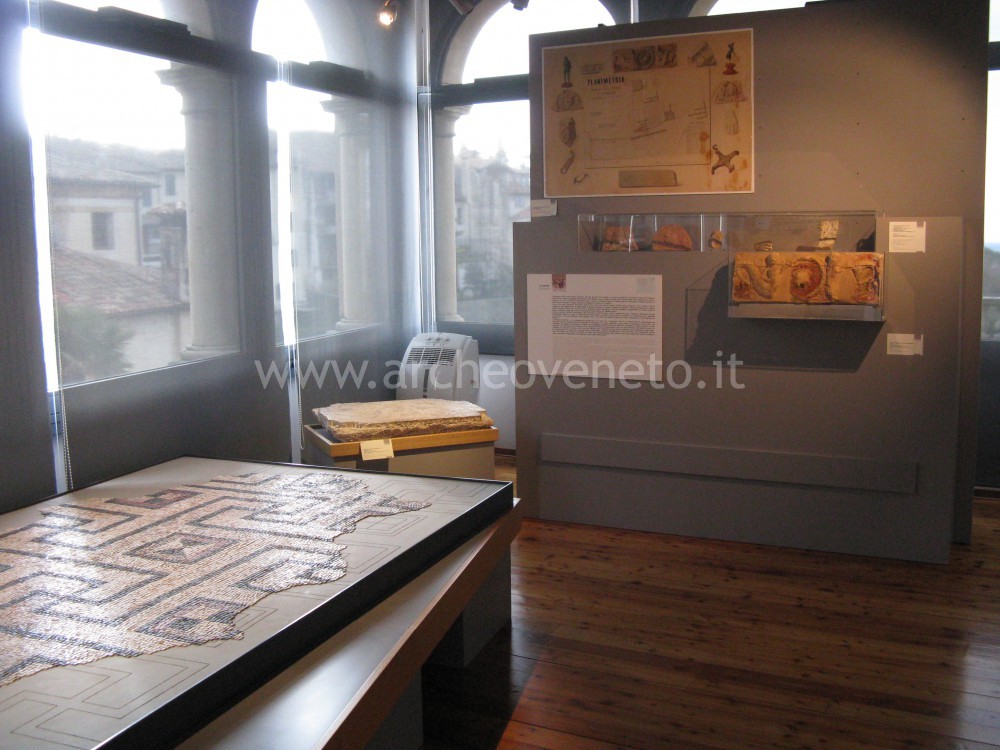 The room contains the archaeological finds of the two main monumental complexes of the Roman period, which have been identified so far in Asolo: the thermae (piazza Brugnoli) and the theatre (garden of Villa Freya). The material discovered includes reliefs (a covering slab with Tritons and Gorgoneions), architectural elements (three cornices, a Corinthian capital and two decorated antefixes) or decorations (a fragment of a floor mosaic). The description of the ancient buildings, which were discovered by Scomazzetto in the mid nineteenth century, is accompanied by a planimetric map and the presumed reconstruction of the elevations. In the same room there are also some examples of statues (alabaster male head, the bust of a small statue and a hand) and of bronze decorative plastic art (a Putto, a Lar, a Venus, a Mercury, an Artemis, a Silenus and a boar protome) of the 1st cent. A.D. The room contains the archaeological finds of the two main monumental complexes of the Roman period, which have been identified so far in Asolo: the thermae (piazza Brugnoli) and the theatre (garden of Villa Freya). The material discovered includes reliefs (a covering slab with Tritons and Gorgoneions), architectural elements (three cornices, a Corinthian capital and two decorated antefixes) or decorations (a fragment of a floor mosaic). The description of the ancient buildings, which were discovered by Scomazzetto in the mid nineteenth century, is accompanied by a planimetric map and the presumed reconstruction of the elevations. In the same room there are also some examples of statues (alabaster male head, the bust of a small statue and a hand) and of bronze decorative plastic art (a Putto, a Lar, a Venus, a Mercury, an Artemis, a Silenus and a boar protome) of the 1st cent. A.D.
|

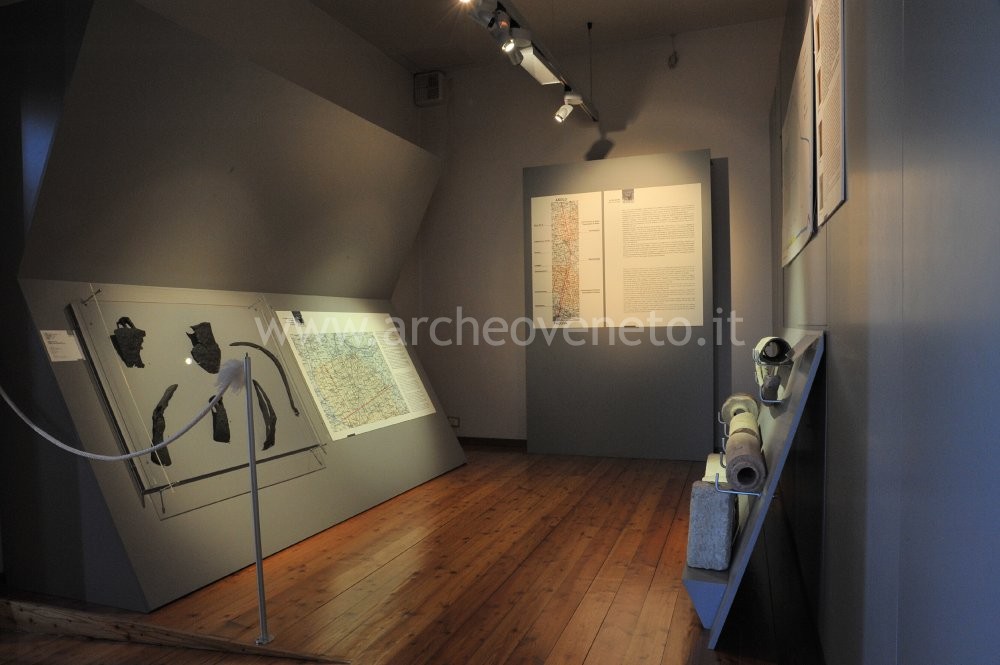 This room contains the material related to the infrastructures of the area surrounding Asolo. Here it is possible to see some remains of the Roman aqueduct (Bot), which was dug in a tunnel under the hill overlooking the town and which was provided with stone, earthen and lead pipes. The same room contains a display case related to the ancient road connecting the municipia of Patavium and Acelum, the via Aurelia, information on which is mainly provided by documentary and toponymic sources, rather than from tangible archaeological finds. The discovery of working tools (hoes, ploughshare, sickle, axe) of the Roman period confirms the important centuriation carried out in the area surrounding Asolo. This room contains the material related to the infrastructures of the area surrounding Asolo. Here it is possible to see some remains of the Roman aqueduct (Bot), which was dug in a tunnel under the hill overlooking the town and which was provided with stone, earthen and lead pipes. The same room contains a display case related to the ancient road connecting the municipia of Patavium and Acelum, the via Aurelia, information on which is mainly provided by documentary and toponymic sources, rather than from tangible archaeological finds. The discovery of working tools (hoes, ploughshare, sickle, axe) of the Roman period confirms the important centuriation carried out in the area surrounding Asolo.
|

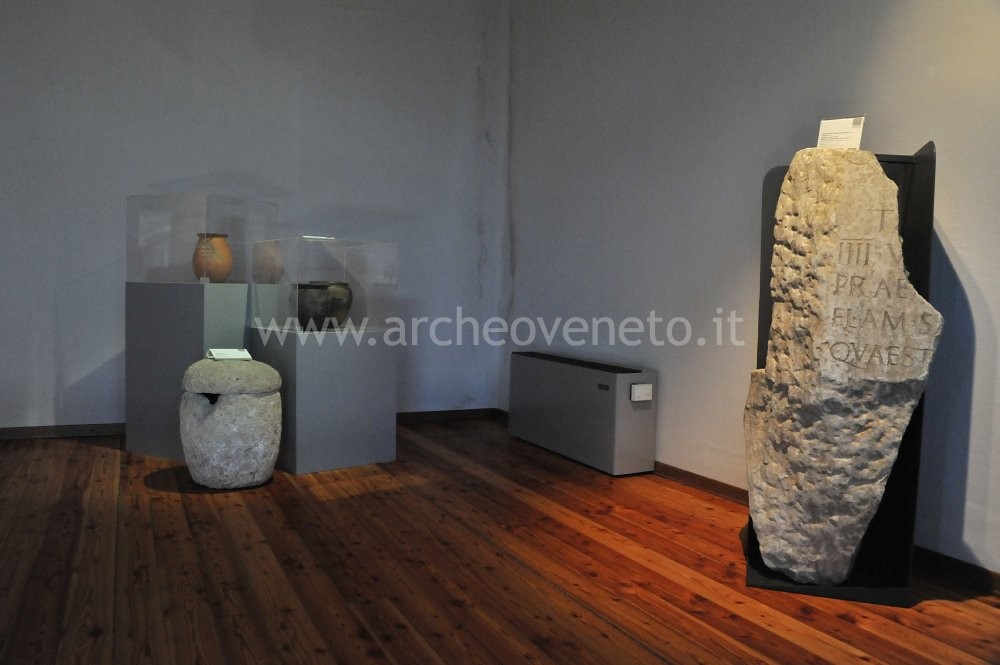 The Roman burial ground of the town was located approximately in the south-eastern suburban area of the city, along the ancient via Aurelia. Often funerary monuments were re-used as building materials in future constructions, as witnessed by the funerary stone of Caius Coelius Taurinus (2nd cent. A.D.) found in the altar of the Church of San Salvaso, by the fragment of the sarcophagus of the 3rd cent. A.D. used for the flooring of the Church of Pagnano or by the fragment of a relief depicting the scene of a funerary banquet used in the façade of the Bishop’s Palace (2nd cent. B.C.). In the room it is also possible to see some examples of stone funerary urns and some fragments of sarcophagi; among them particularly noteworthy is one in Greek marble depicting a scene of Amazonomachy found in Costa Curta (early 3rd cent. A.D.). The Roman burial ground of the town was located approximately in the south-eastern suburban area of the city, along the ancient via Aurelia. Often funerary monuments were re-used as building materials in future constructions, as witnessed by the funerary stone of Caius Coelius Taurinus (2nd cent. A.D.) found in the altar of the Church of San Salvaso, by the fragment of the sarcophagus of the 3rd cent. A.D. used for the flooring of the Church of Pagnano or by the fragment of a relief depicting the scene of a funerary banquet used in the façade of the Bishop’s Palace (2nd cent. B.C.). In the room it is also possible to see some examples of stone funerary urns and some fragments of sarcophagi; among them particularly noteworthy is one in Greek marble depicting a scene of Amazonomachy found in Costa Curta (early 3rd cent. A.D.).
|

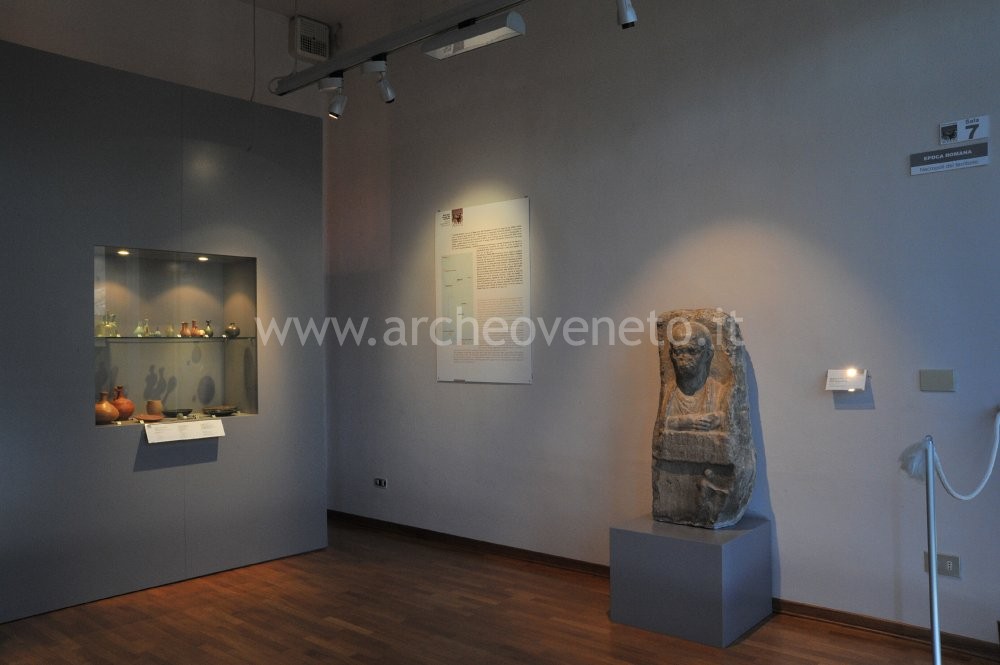 This room contains the remains of the burials found in the area surrounding Asolo (Riese Pio X, Altivole, Fonte Alto) belonging to smaller settlements. The only funerary monument that can be seen in the room is the stele of Velleius from Fonte Alto, which can be dated back to the 1st cent. A.D., whereas the other objects displayed are grave goods. The material found in Riese Pio X includes artefacts covering a time span from 1st to 3rd cent. A.D., including a pyriform olpe, a globular olpe, a sigillata patera and two bronze paterae, a thin-walled cup, glass, earthen and bronze unguentaria, a glass bottle, a bronze aryballos and bone objects. This room contains the remains of the burials found in the area surrounding Asolo (Riese Pio X, Altivole, Fonte Alto) belonging to smaller settlements. The only funerary monument that can be seen in the room is the stele of Velleius from Fonte Alto, which can be dated back to the 1st cent. A.D., whereas the other objects displayed are grave goods. The material found in Riese Pio X includes artefacts covering a time span from 1st to 3rd cent. A.D., including a pyriform olpe, a globular olpe, a sigillata patera and two bronze paterae, a thin-walled cup, glass, earthen and bronze unguentaria, a glass bottle, a bronze aryballos and bone objects.
Then there are the finds discovered in the site of Altivole (1st cent. B.C. – 1st cent. A.D.), which include a funerary urn with its lid, an olpe with carinate shoulder, a patera and a bowl with black varnish decoration, an olpe with three-lobed rim, a pyriform olpe, a thin-walled cup, a jug, a bowl and two mortar bowls with grater.
The last display case contains the funerary goods of a burial dating back to Late Antiquity (4th-5th cent. A.D.) discovered in Fonte Alto, which include a double-handled jug, a small jug, a sigillata bowl with stamp, a bowl with its lid, a necklace fragment, a lamp with menorah (seven-branched candelabrum) decoration and some armillae.
|

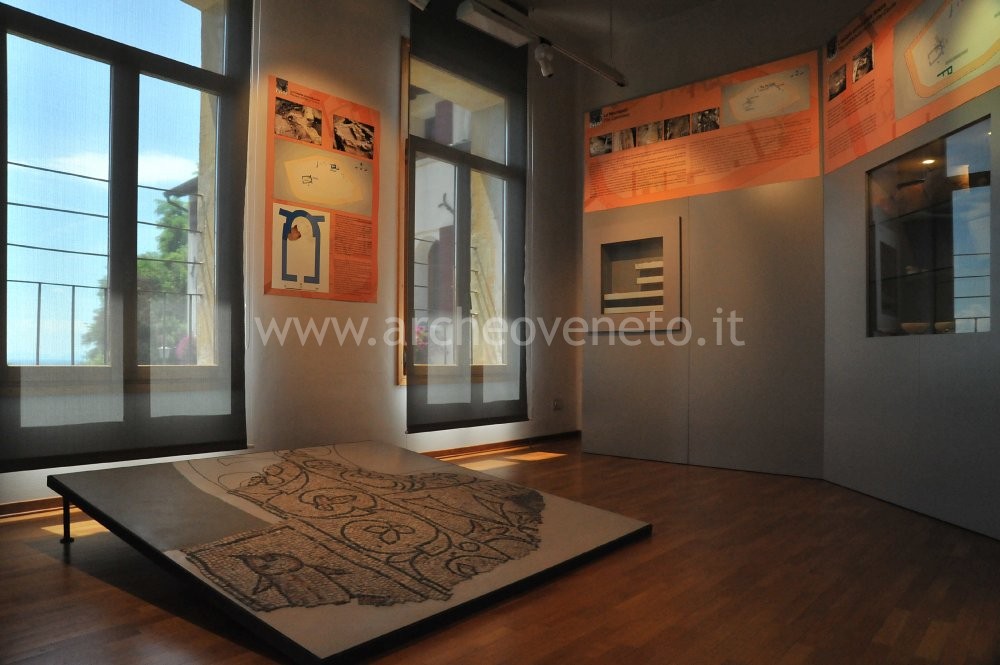 This room contains the findings of the excavation carried out in the medieval Rocca that dominates the city of Asolo from the top of Monte Ricco. Particularly is exhibited a mosaic from a little church discovered in the top oh the hill in 1987. This room contains the findings of the excavation carried out in the medieval Rocca that dominates the city of Asolo from the top of Monte Ricco. Particularly is exhibited a mosaic from a little church discovered in the top oh the hill in 1987.
|
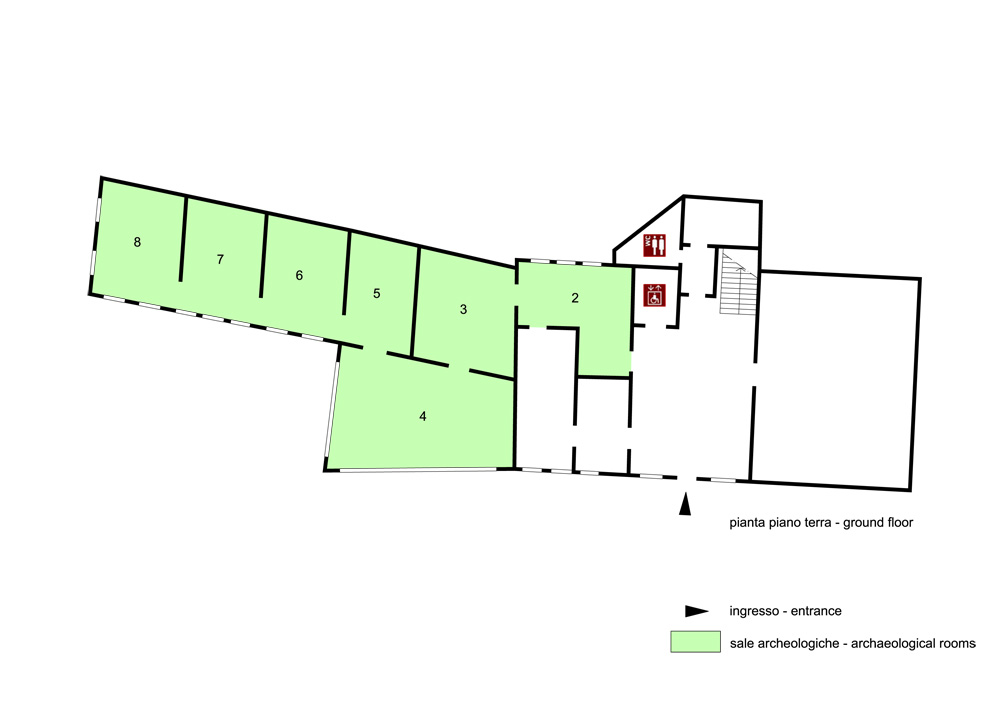
Admission: Negli orari di apertura
Su prenotazione
Ticket: Si
Price: Full fare: 5 €; reduced fare : 4 €; school classes: 2,50 €; famiglie (2 adulti e 2 minorenni) 12 €.
Cumulativo Museo + Rocca: intero 6 €; ridotto 5 €.
Cumulativo Museo + Rocca per famiglie: 15 €.
 School access School access
 Disabled access Disabled access
Opening Days
| Tipology |
When |
Specs |
| Summer/Winter |
Monday |
Upon reservation for schools |
| Summer/Winter |
Tuesday |
Upon reservation for schools |
| Summer/Winter |
Wednesday |
Upon reservation for schools |
| Summer/Winter |
Thursday |
Upon reservation for schools |
| Summer/Winter |
Friday |
Upon reservation for schools |
| Summer/Winter |
Saturday |
10.00 – 19.00 |
| Summer/Winter |
Sunday
|
10.00 – 19.00 |
Recommended tour time (minutes): 45
 Toilet Toilet
 Bookshop Bookshop
 Rest points Rest points
 Brochure Brochure
Italian and English
 Information boards Information boards
Italian and English
 Captions under exhibits Captions under exhibits
Italian and English
 PC learning points PC learning points
 Multilingual ads: Inglese Multilingual ads: Inglese
Brochures, panels and captions on the works.
 Guided Tours Guided Tours
 Educational activities Educational activities
 Educational workshops Educational workshops
 Library and documentation centre Library and documentation centre
 Other activities Other activities
| Musei e raccolte archeologiche del Veneto 2004, a cura di Di Mauro A., Dosson di Casier, pp. 80-82. |
| Bonetto J. 2009, Veneto (Archeologia delle Regioni d’Italia), Roma, pp. 414-415. |
|



 School access
School access Disabled access
Disabled access Brochure
Brochure Information boards
Information boards Captions under exhibits
Captions under exhibits PC learning points
PC learning points Multilingual ads: Inglese
Multilingual ads: Inglese Guided Tours
Guided Tours Educational activities
Educational activities Educational workshops
Educational workshops Library and documentation centre
Library and documentation centre Other activities
Other activities































